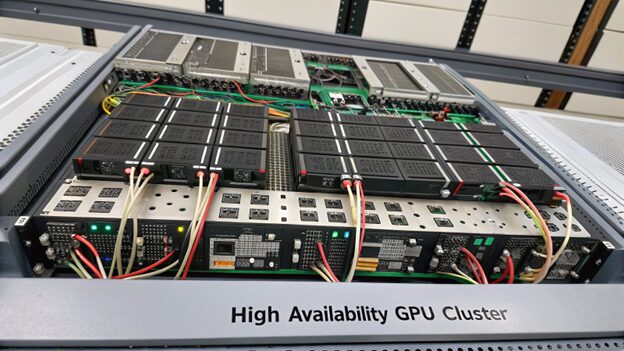How High-Availability GPU Clusters Work

In the field of modern computing, high-availability GPU clusters have become the backbone of demanding computational tasks, from artificial intelligence (AI) training to high-performance computing (HPC) simulations. But how do these clusters ensure uninterrupted performance, fault tolerance, and scalability? This article dives into the mechanics, architecture, and applications of high-availability GPU clusters, providing a comprehensive guide for tech enthusiasts and IT professionals alike.
What Is a High-Availability GPU Cluster?
A high-availability GPU cluster is a distributed computing system comprising multiple nodes. These clusters are designed to provide continuous service, even in the face of hardware failures, by leveraging advanced fault-tolerant mechanisms and redundancy. This ensures that critical computational workloads remain uninterrupted, making these clusters indispensable in fields like AI, deep learning, scientific modeling, and more.
- Nodes: The computational powerhouses responsible for parallel processing.
- Networking Components: High-speed interconnects that enable seamless data exchange.
- Storage Systems: Distributed file systems that ensure data integrity and accessibility.
The Core Principles of High-Availability
High availability is achieved through a combination of architectural redundancy, automated failover mechanisms, and intelligent resource management. Here are the essential principles:
- Redundancy: Duplicate hardware components and data replication prevent single points of failure.
- Automated Failover: When a node fails, workloads are seamlessly transferred to healthy nodes.
- Load Balancing: Ensures even distribution of tasks across GPU resources to maximize efficiency.
How GPU Clusters Work
The operation of GPU clusters revolves around task distribution, fault detection, and resource scaling. Below is a breakdown of their working mechanism:
- Task Scheduling: A central scheduler assigns workloads to GPU nodes based on their capacity and availability.
- Fault Detection: Monitoring tools continuously check node health, triggering automated recovery if a failure occurs.
- Dynamic Scaling: Resources are scaled up or down based on real-time computational demands.
- Data Synchronization: Distributed file systems ensure that data remains consistent across nodes.
Applications of High-Availability GPU Clusters
These clusters empower a wide range of industries and use cases:
- AI and Machine Learning: Accelerating model training and inference through massive parallelism.
- Scientific Computing: Solving complex simulations in physics, chemistry, and biology.
- Rendering and Visualization: Enabling real-time rendering for animations and simulations.
- Cloud Computing: Powering hosting and colocation services for global accessibility.
Key Technologies for Building GPU Clusters
Building a high-availability GPU cluster requires careful selection of hardware and software components:
- Hardware: High-performance GPUs, fast storage solutions, and low-latency networking equipment.
- Cluster Management Tools: Software that handles scheduling, monitoring, and resource allocation.
- Distributed File Systems: Ensuring fault-tolerant data storage and retrieval.
Why Choose GPU Hosting or Colocation Services?
For organizations looking to leverage high-availability GPU clusters without the complexities of in-house management, the hosting or colocation services can be a game-changer. These services provide:
- Scalability: Easily add or remove resources based on your computational needs.
- Cost Efficiency: Pay only for the resources you use, eliminating upfront hardware costs.
- Global Accessibility: Minimize latency with strategically located data centers.
Conclusion: The Future of High-Availability GPU Clusters
As computational demands continue to grow, high-availability GPU clusters will play an increasingly critical role in ensuring performance, reliability, and scalability. Whether through in-house deployment or leveraging the hosting and colocation services, these clusters are poised to revolutionize industries ranging from AI to scientific research. By understanding their architecture and functionality, organizations can harness their full potential and stay ahead in the competitive landscape.
High-availability GPU clusters stand as a testament to the power of distributed computing, offering a solution that bridges fault tolerance with unparalleled computational capabilities.
